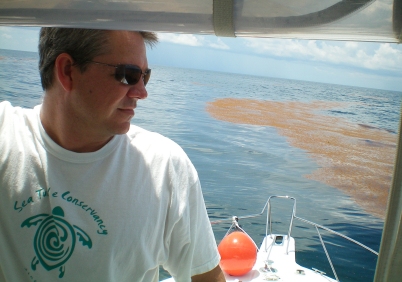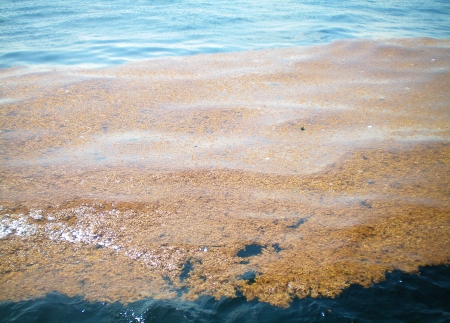Today’s blog post about working with sea turtles in Costa Rica is by Brian Drozd, a program officer at the U.S. Department of State. He has over 6 years of experience working for the United States Environmental Protection Agency, where he worked on grants and communications in the Climate Change Division. His Master’s degree in Natural Resources and Sustainable Development enabled him to focus on sustainable tourism and conservation.
In the summer of 2009 I spent 10 weeks working with sea turtles on the rugged coast of Tortuguero, Costa Rica. Working as a research assistant for the Sea Turtle Conservancy, I spent my time walking up and down a 5 mile stretch of beach in the middle of the night looking for green sea turtles to measure, tag, and count the number of eggs they laid. I did this only for meals and a roof over my head. Why would someone do this? Sea turtles have swum in the world’s oceans for 100 million years, and they are in danger of extinction. Threats from poaching, commercial fishing, and climate change, among others, are threatening these animals all over the world. Many people say healthy sea turtles mean healthy oceans.
There are many different species of sea turtles, but I primarily worked with green sea turtles. Some facts about these amazing animals:
The goal of my time in Tortuguero was to help the Sea Turtle Conservancy collect data to monitor the health and numbers of the sea turtle population. We also worked closely with the local people to educate them about sea turtles and help them conduct their eco-tourism business with the turtles in a safe manner.
One of the most amazing experiences as a research assistant was when we put a satellite transmitter onto a green turtle. Using a transmitter to monitor turtles we are able to learn about their feeding patterns, how long they stay under water, and much more. It is just this kind of valuable information that is helping scientists learn how to better help protect these animals.
Sea Turtles nest all over the world. Large nesting populations are found in many countries in Latin America and Africa, as well as in India, Indonesia, and China. All sea turtles are in need of protection, monitoring, and research in order to make sure they survive for future generations. There are many actions you can take to help sea turtles near your home and around the world. Some of them are: reducing pollution, not eating sea turtle meat or eggs, and protecting coastlines by slowing development and reducing light on nesting beaches. View more tips here and research just a few of the many organizations working to save turtles around the world. I had an incredible time working with sea turtles, and I’m sure you would too!
This blog was originally posted on the Global Conversations: Climate Blog )
Each nesting season, STC invites students and recent college graduates to assist with research at Tortuguero in Costa Rica. During this year’s leatherback nesting season, research assistant Maddie will be sharing her experience with STC’s members and supporters.
Meet Maddie
“¡Hola! Mi nombre es Madeleine Beange. I grew up in beautiful Vancouver, Canada. In 2009, I completed a B.S in neurobiology at McGill University. After a year of neuroscience research I got sick of killing mice.
I left my lab job to backpack Southeast Asia for a couple months. After a taste of wandering the world, I realized I needed more. Pursuing my dreams of working with sea turtles, I worked for 9 months and saved up enough money to fly to Costa Rica.
My fist experience with sea turtle conservation research was with PRETOMA, a Costa Rican NGO. From October to December 2011, I worked as a coordinator/research assistant for 3 months.
Next up is a 3 month research assistant position with Sea Turtle Conservancy. I will still be working in Costa Rica, but this time on the Caribbean side in Tortuguero.”
To read about Maddie’s adventures as a Sea Turtle Conservancy research assistant, click here for her blog, Mad About Sea Turtles.
I recently was invited to join a team of veterinarians and biologists working for NOAA and the BP oil spill Unified Command on a trip into the Gulf of Mexico to document and rescue sea turtles impacted by oil. The trip also gave me an opportunity to observe first-hand the current status of ocean-surface conditions and the availability of suitable sea turtle habitat in that region of the Gulf.
 The 12-hour voyage departed from Venice, Louisiana, a small fishing community located at the southernmost point of land where the Mississippi River spills into the Gulf. Joining me on the trip were Dr. Brian Stacy, a NOAA veterinarian based at the University of Florida who has been coordinating sea turtle rescue efforts in the waters south of New Orleans and Dr. Joe Flanagan (a vet from the Houston Zoo). Also participating was Jonathan Gorham of In-water Research Group and representatives from two other conservation organizations (Chris Pincetich of the Sea Turtle Restoration Project and John Hammond with the National Wildlife Federation). Our primary task was to locate and rescue any sea turtles that might have been impacted by the oil spill.
The 12-hour voyage departed from Venice, Louisiana, a small fishing community located at the southernmost point of land where the Mississippi River spills into the Gulf. Joining me on the trip were Dr. Brian Stacy, a NOAA veterinarian based at the University of Florida who has been coordinating sea turtle rescue efforts in the waters south of New Orleans and Dr. Joe Flanagan (a vet from the Houston Zoo). Also participating was Jonathan Gorham of In-water Research Group and representatives from two other conservation organizations (Chris Pincetich of the Sea Turtle Restoration Project and John Hammond with the National Wildlife Federation). Our primary task was to locate and rescue any sea turtles that might have been impacted by the oil spill.
Rescue efforts such as this have been underway since shortly after the spill began, and they continue out of several port cities around the Gulf. Since the start of the disaster at the end of April, nearly 1,000 sea turtles have either stranded on Gulf Coast shores or have been recovered at sea through rescue efforts such as this.
 Our trip took us about 50 miles into the Gulf, where we began to spot mats of floating sargassum weed-an important pelagic habitat for both juvenile and hatchling sea turtles. Aside from tiny pieces of plastic and other types of common marine debris mixed in with the sargassum, the habitat we encountered appeared quite healthy. In fact, the mats were teaming with fish and other important marine species such as small shrimp, crabs and other vertebrates and invertebrates that sea turtles feed upon. Over the course of the day we also spotted and recovered two juvenile Kemp’s ridleys that showed no sign of having come in contact with oil.
Our trip took us about 50 miles into the Gulf, where we began to spot mats of floating sargassum weed-an important pelagic habitat for both juvenile and hatchling sea turtles. Aside from tiny pieces of plastic and other types of common marine debris mixed in with the sargassum, the habitat we encountered appeared quite healthy. In fact, the mats were teaming with fish and other important marine species such as small shrimp, crabs and other vertebrates and invertebrates that sea turtles feed upon. Over the course of the day we also spotted and recovered two juvenile Kemp’s ridleys that showed no sign of having come in contact with oil.
Considering that this very region of the Gulf was once thickly coated with oil, it seems most likely to me that the sargassum we encountered had drifted into the area, likely from the west, where it never came in contact with oil. Since the beginning of the spill, large amounts of oil-soaked sargassum have been corralled and burned by BP and its contractors. An undetermined amount of oil-soaked sargassum also has died and sunk below the surface by now. In this way, a substantial amount of important turtle habitat has been eliminated from the Gulf. However, this trip gave me great hope that sea turtles and their sargassum habitat are moving back into the region, but full recovery will take significantly longer.
My most striking memory from the trip is the complete absence of oil on the surface, despite our close proximity to the Deepwater Horizon oil spill site. On one hand I found it encouraging that the habitat, at least on the surface, appeared healthy. Unfortunately, conditions on the surface don’t tell the entire story about how oil and chemicals used to disburse the spill continue to impact the wildlife and ecology of the Gulf of Mexico. For government and non-government biologists alike, this remains a major concern, and research on what is happening below the surface needs to continue.
Based on my observations on this day and in this location, the surface habitat for sea turtles appears to be recovering a lot faster than most people, including me, thought would be possible. NOAA and other personnel responding to oil-impacted sea turtles are suggesting that their efforts to recover turtles at sea will soon wind down. While in hindsight it would have been better if more boats and rescue personnel had been in place to rescue turtles at the height of the spill, I can’t find fault with agency plans to scale back now. In fact, at this point chasing little Kemp’s ridleys out of healthy habitat seems more intrusive than helpful. Other threats to sea turtles, and especially the risk posed by the reopening of shrimp trawling in Louisiana waters, where state law does not require shrimpers to use Turtle Excluder Devices, presents a more significant survival threat to both loggerheads and Kemp’s ridleys. As efforts to rescue oil-impacted sea turtles wind down, state and federal regulators need to focus on bringing Louisiana commercial fishing regulations into the 21st century, where the harvesting of shrimp is done in ways that safeguard sea turtles and other common bycatch.
David Godfrey
STC Executive Director